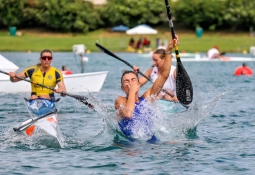Folding kayaks, an Austrian organ builder, and an athlete who had to build his own boat because he was too big to fit into traditional canoes were all part of the first official appearance of canoe sprint at an Olympic Games, in Berlin in 1936.
Canoe sprint had been a demonstration sport in 1924, but it took another three Games before it was officially welcomed onto the programme.
Check out rare video from 1936
And what an impact it made! Nine events altogether, including two races for folding kayaks, 119 athletes from 19 nations, with Austria leading the medal charge ahead of Germany, with eight nations sharing medals.
In 1936 it was a men-only event, with races contested over 1000 and 10,000 metres.
Sweden’s Erik Bladstram, at 18, was the youngest athlete in the competition, while 40-year-old William Gaehler from the United States was the oldest.
The star of 1936 was Austria’s Gregor Hradetzky, a 27-year-old organ builder who only took up the sport as a 17-year-old. But he had already established himself as an exceptional sportsman, excelling at cross-country skiing and ski jumping.
Check out this rare interview with Gregor Hradetzky
In fact, he also tried to qualify for the 1936 Winter Olympics, but had to withdraw because of a hand injury.
He went to Berlin as a two-time European champion in the folding K1 10,000 and made good that form with an impressive victory. He also won the K1 1000, becoming just the second Austrian to win two gold medals at a Summer Olympics. No Austrian has since repeated that feat.
Like many, the second World War ended Hradetzky’s sporting career. After the War he took over the family organ-building business, and became internationally recognized for the quality of his work. His company installed organs in the United States, Japan and at the Sydney Opera House in Australia.
Hradetzky received the Olympic order in Bronze in 1981, and remains to this day the most successful Austrian canoe sprint athlete of all time. He died in 1984.
See more rare video from 1936 here
Frank Amyot won Canada’s only canoe sprint gold medal in 1936, in the men’s C1 1000. His journey to Olympic glory was a difficult one. He was too poor to buy his own canoe when he took up the sport, and too big to fit in most of the others available, so he built his own.
Amyot was already a Canadian hero. In June 1933, he saved two members of the Ottawa Rough Riders football team from drowning in Lake Deschenes, after their canoe overturned.
He went to Berlin as captain and manager of the Canadian delegation, but had to raise his own funds to get to the Games. It was money well spent. Despite not having trained in the C1 until he arrived in Germany, he triumphed in a six-man field to earn Canada its only gold medal of the Berlin Olympics.
Surprisingly in the K1, which was his preferred discipline, he was eliminated in the heats.
Amyot went on to forge a successful career as a sports administrator, and was a tireless campaigner for funding for athletes to get to Olympic Games. He was a inducted into the Canadian Olympic Hall of Fame in 1949, and the Canadian Sports Hall of Fame in 1955.
Mountaineer and champion cross-country skier, Ernst Krebs, won the other individual gold in Berlin. The 29-year-old German triumphed in the K1 10,000 metres. Tragically he died after falling from a ladder in 1971 while trying to fix a gutter.
And what of these folding kayaks? This was their one and only appearance at an Olympics, with races contested in K1 and K2 over 10,000 metres.
The kayaks had a wooden framework inside, which meant they could pack almost flat for storage or transportation. Revolutionary at the time, they were never to be seen at an Olympics again.
See more rare video from 1936 here
#20in2020




